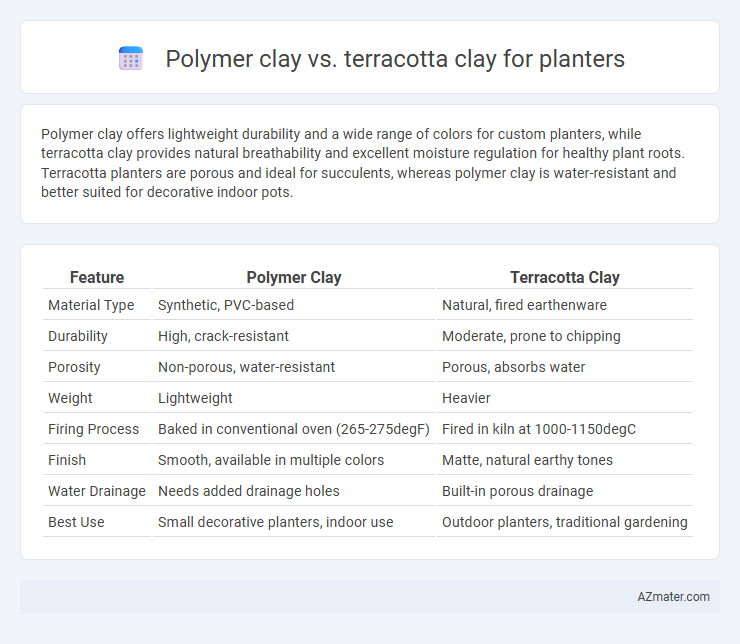Polymer clay offers lightweight durability and a wide range of colors for custom planters, while terracotta clay provides natural breathability and excellent moisture regulation for healthy plant roots. Terracotta planters are porous and ideal for succulents, whereas polymer clay is water-resistant and better suited for decorative indoor pots.
Table of Comparison
| Feature | Polymer Clay | Terracotta Clay |
|---|---|---|
| Material Type | Synthetic, PVC-based | Natural, fired earthenware |
| Durability | High, crack-resistant | Moderate, prone to chipping |
| Porosity | Non-porous, water-resistant | Porous, absorbs water |
| Weight | Lightweight | Heavier |
| Firing Process | Baked in conventional oven (265-275degF) | Fired in kiln at 1000-1150degC |
| Finish | Smooth, available in multiple colors | Matte, natural earthy tones |
| Water Drainage | Needs added drainage holes | Built-in porous drainage |
| Best Use | Small decorative planters, indoor use | Outdoor planters, traditional gardening |
Introduction to Polymer Clay and Terracotta Clay
Polymer clay is a versatile, synthetic material made from polyvinyl chloride (PVC) combined with plasticizers, allowing it to be easily molded and cured at low temperatures, making it ideal for detailed and lightweight planters. Terracotta clay, derived from natural clay fired at high temperatures, is porous and durable, offering a rustic, earthy aesthetic and excellent breathability for plant roots. Both materials serve as popular choices for planters but differ significantly in texture, durability, and maintenance requirements.
Material Composition and Properties
Polymer clay, composed primarily of polyvinyl chloride (PVC) combined with plasticizers, offers high flexibility, lightweight properties, and cures at low temperatures through baking, making it ideal for detailed, small-scale planters. Terracotta clay, made from natural earthen materials rich in iron oxide, is porous and durable, requiring high-temperature kiln firing to achieve hardness and breathability, which supports healthy root aeration in large outdoor planters. The non-porous, waterproof nature of polymer clay suits decorative indoor use, while terracotta's natural moisture-wicking ability makes it preferable for functional, traditional gardening applications.
Workability and Crafting Techniques
Polymer clay offers exceptional workability with its pliable texture that remains soft until baked, allowing for intricate detailing and precise shaping. Terracotta clay requires moist handling and gradual drying, making it ideal for traditional wheel throwing and hand-building techniques but less forgiving for delicate designs. Crafting a planter with polymer clay enables fine sculpting and color customization, while terracotta provides natural breathability and durability after kiln firing.
Durability and Longevity of Planters
Polymer clay planters offer superior durability due to their resistance to cracking, chipping, and weather exposure, making them ideal for both indoor and outdoor use. Terracotta clay, though aesthetically classic and porous for plant root aeration, is more susceptible to breakage, frost damage, and wear over time. Longevity of polymer clay planters generally surpasses terracotta, especially in harsh climates or frequent handling conditions.
Weight and Portability Comparison
Polymer clay planters are significantly lighter than terracotta clay ones, making them easier to move and rearrange indoors or on balconies. Terracotta clay planters tend to be heavier and more fragile, which limits portability but offers better stability for larger plants. Choosing polymer clay enhances portability for small to medium planters, while terracotta provides a robust base for outdoor and heavier plant setups.
Water Absorption and Plant Health
Polymer clay has minimal water absorption, providing a waterproof barrier that prevents moisture loss, which can benefit plants requiring consistent hydration but may lead to root rot due to insufficient drainage. Terracotta clay is highly porous, allowing excellent water absorption and evaporation that promotes aeration and prevents overwatering, enhancing overall plant health in drought-tolerant species. Choosing polymer clay planters suits moisture-sensitive plants, while terracotta planters are ideal for species needing well-drained, breathable soil conditions.
Aesthetic Possibilities and Customization
Polymer clay offers extensive aesthetic possibilities with its vibrant colors, smooth textures, and the ability to mimic various finishes, making it ideal for intricate, customizable planter designs. Terracotta clay provides a natural, earthy look with warm reddish-brown tones and a porous texture that enhances rustic and traditional planter aesthetics. Customization with polymer clay is more versatile due to its moldability and compatibility with paints and embellishments, while terracotta allows for hand-carving and glazing options that create unique, artisanal finishes.
Environmental Impact and Sustainability
Polymer clay, a synthetic material, is non-biodegradable and derived from petrochemicals, which contributes to environmental pollution and a larger carbon footprint compared to terracotta clay. Terracotta clay is a natural, biodegradable material made from fired clay, making it a more sustainable and eco-friendly option for planters due to its ability to break down naturally and lower environmental impact. The energy used in firing terracotta is relatively low, and the material is recyclable, while polymer clay requires energy-intensive manufacturing and generates plastic waste.
Cost and Accessibility for Crafters
Polymer clay, known for its affordability and widespread availability in craft stores and online, offers crafters a cost-effective option with no need for kiln firing, making it accessible for beginners and hobbyists. Terracotta clay requires kiln access for firing, which can increase overall expenses and limit accessibility, especially for those without studio facilities. While terracotta provides a natural, porous finish ideal for plant breathability, polymer clay's cost-efficient materials and ease of use make it a preferred choice for budget-conscious crafters.
Best Uses: Choosing the Right Clay for Your Planter
Polymer clay offers exceptional versatility and durability for indoor planters, providing lightweight, moisture-resistant options ideal for detailed designs and small pots. Terracotta clay is best suited for outdoor planters due to its porous nature, allowing better air and water circulation that supports healthy root growth and prevents overwatering. Selecting the right clay depends on your planter's environment and purpose, with polymer clay favored for decorative, indoor use and terracotta clay preferred for traditional, breathable, outdoor planters.

Infographic: Polymer clay vs Terracotta clay for Planter
 azmater.com
azmater.com